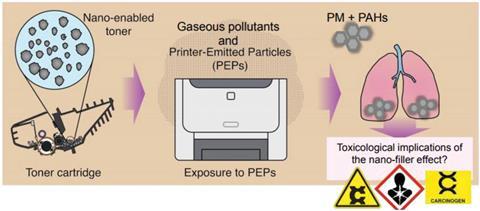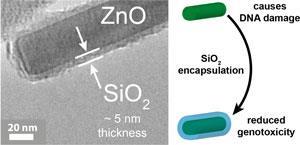Surprising chemical differences between toner powders and particles emitted by printers

Researchers in the US have observed that compounds in printer toners interact with each other during the printing process to make and emit particles with a higher carcinogenic potential than previously thought.
Over the past 5 years, Philip Demokritou at Harvard University has led a team that assess the health implications of nanomaterials in printer toners, discovering that they become airborne during printing. The team conducted both in vitro and in vivo studies to assess the specific toxicological effects of these nanoparticles in animals. They found that, due to their small size, the nanoparticles can enter the lungs and even reach the bloodstream.
This is the first study to realise that worrying transformations take place during the printing process. Laser printers, commonly found in office and home environments, use toners that contain catalytically active nanoparticles. Printing emits these nanoparticles into the air. Here the nanoparticles can react with volatile organic compounds to form potentially carcinogenic compounds, which people can inhale and accumulate in their lungs.
Using nuclear magnetic spectroscopy and gas chromatography mass spectrometry to determine the organic species in these nanomaterials, the researchers proved that low molecular weight gaseous polycyclic aromatic hydrocarbons from toner powders interact with these catalytic nanoparticles and, under the high temperatures used during printing, form high molecular weight species. These heavier species pose a health risk as they are potentially carcinogenic and mutagenic.
Demokritou says that ‘assessing the nano-risk early on during product development while there is still a window to apply “safer-by-design” approaches can maximise the benefits of using nanoscale materials while minimising the potential health implications’.
Vicki Grassian, an expert in nanoscience and its implications on health and the environment at the University of California San Diego, US, says it is important to understand nanotechnology so that we can use it sustainably, but still benefit from the unique properties of nanoparticles. ‘As a scientist, I always want to know more about what is going on in terms of nanoparticle and organic compound emissions, to see under what situations we can try and prevent these things from happening,’ she says.
Demokritou is now involved in a partnership between Harvard University and Nanyang Technological University in Singapore, which aims to analyse biological samples from humans in photocopying centres, to develop a deeper understanding of the effects of prolonged exposure to these nanomaterials.
References
This article is free to access until 17 November 2017
M-C G Chalbot et al, Environ. Sci.: Nano, 2017, DOI: 10.1039/c7en00573c











1 Reader's comment